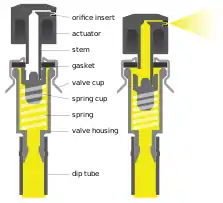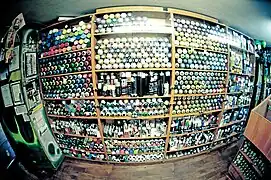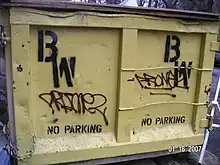Aerosol paint
Aerosol paint (commonly spray paint) is paint that comes in a sealed, pressurized container and is released in an aerosol spray when a valve button is depressed. The propellant is what the container of pressurized gas is called. When the pressure holding the gas is released through the valve, the aerosol paint releases as a fine spray.[1] Aerosol painting is one form of spray painting; it leaves a smooth, even coat, unlike many traditional rolled and brushed paints. Aerosol primer can be applied directly to bare metal and many plastics.

Most aerosol paints also have a metal, marble, glass or plastic ball called a pea inside of the can, which is used to mix the paint when the can is shaken.
Aerosol paint needs different types of plastic-like polymers to make it work. The most commonly used are alkyds and acrylics. Polyvinyl acetate (PVA) is another substitute for acrylics. Different companies will use specific mixes of polymers and plasticizers (like dibutyl phthalate and dibutyl meleate) to make the spray paint flexible and durable. [2]
History
In 1949, Edward H. Seymour, of Sycamore, Illinois,[3] added paint to existing spray can technology at his wife Bonnie's suggestion. It was initially designed to demonstrate an aluminum paint he developed.[4] His patent was awarded in 1951.[5] Spray paint has been used in modern graffiti since its origins, when TAKI 183 began tagging with spray paint.[6]
Uses

Acrylic-based craft primers and vinyl dye can be used on plastics like models or miniatures.
Most brands include a wide variety of paints, including primers, heat, and traffic resistant enamels, gloss and matte finishes, metallic colors, and textured paints for home decor.
Aerosol paint is useful for quick, semi-permanent marking on construction and surveying sites. Inverted cans for street, utility or field marking can be used upside-down with an extension pole. APWA (American Public Works Association) has standardized colors for utility and excavation markings. Hiking trails can also be marked with aerosol paint trail blazes.
Small to medium-sized repairs to automobile bodywork can be completed by enthusiasts at home using aerosol paint, though to paint an entire vehicle in this manner would be difficult and expensive. The main disadvantages, compared to a professional spray gun, include the limited quality provided by the built-in nozzle and the lack of infrared baking after applying the paint, which indicates that the paint could take several months to obtain its final hardness.
In art
Graffiti and street art uses
Graffiti artists are known to use spray paint because the medium is quick, permanent, and portable. The origin of the product, however, dates back to 1949, when it was designed for the very practical purpose of applying aluminum paint coatings to radiators.[4]
Speed, portability, and permanence make aerosol paint a common graffiti medium. In the late 1970s, street graffiti writers' signatures and murals became more elaborate and a unique style developed as a factor of the aerosol medium and the speed required for illicit work. Many now recognize graffiti and street art as a unique art form and specifically manufactured aerosol paints are made for the graffiti artist.
Graffiti artist paints tend to be more expensive, but have a wider selection of rich colors, are thicker and less likely to drip. They are produced in standard high-pressure cans for fast, thick coverage and lower pressure cans for more control and flexibility. Most art brand paints have two or three mixing peas in a can. A wide array of actuators or caps are available, from standard "skinny" caps to wider "fat" caps, as well as caps that control the softness or crispness of the spray. Calligraphy caps create fan spray instead of the standard round.

 Street art style can. A) Color identity "donut"; B) Valve cup; C) Gasket for spray valve; D) Peas; E) Actuator.
Street art style can. A) Color identity "donut"; B) Valve cup; C) Gasket for spray valve; D) Peas; E) Actuator. Spray paint cap after use with several paints
Spray paint cap after use with several paints
Stencils

When aerosol paint is used, a stencil can keep the paint constrained to one area. This protects the masked area from being covered in unwanted paint. Stencils can be purchased as movable letters, ordered as professionally cut logos, or hand-cut by artists.
Stencils can be used multiple times for recognition and consistency. Official stencils can be used to quickly and clearly label objects, vehicles or locations. Graffiti writers can use stencils to quickly mark in busy places or leave recognizable tags over a large area. Stencil artists often use multiple colors, or create elaborate stencils that are works of art in themselves.
Illicit use
Graffiti
Unauthorized graffiti is considered to be vandalism in most jurisdictions mainly because the work or display is done without permission of the property owner. The term 'aerosol art' is commonly used for displaying art form 'with' permission of the property owner. The UK and many cities in the United States prohibit the sale of aerosol paint to minors as part of graffiti abatement programs.[7] While major industrial and consumer aerosol paint companies like Krylon and Rust-Oleum actively participate in anti-graffiti programs, art-brand companies are often supportive of writers and graffiti culture, though most do not endorse illegal writing.
Graffiti is removed through four main methods. The first is pulsed laser cleaning (PLC). Some common methods include using pressurized water or chemical treatments. Another method is covering up the graffiti with a coat of paint, though this is not an ideal method since it causes heavy paint build-up and leaves an obvious patch of paint that draws the eye. When removing paint, the following factors need to be taken into account: pigment (what material(s) make up the color and opacity), binder (what holds the paint together), and solvents and additives.
Inhalant
Like many household chemicals and aerosols, aerosol paint vapor and propellant can be misused as an inhalant.[8] Such misuse can cause a circumstance called "sudden sniffing death." This is a very common occurrence when inhaling aerosol paint. [9] Other dangers when using aerosol paint as an inhalant includes respiratory, eye, and nasal irritation. This can lead to illnesses that damage the lungs such as bronchitis and pulmonary edema. [10]
Typically people who use inhalants will display some indicators. These include paint stains on the person, hidden/empty cans, chemical odors, and may overall appear drunk.
See also
References
- Aerosol Dispenser. 2018.
- Sanmartin, P.; Cappitelli, F.; Mitchell, R. (2014). Current Methods of Graffiti Removal:A Review.
- "Discover the history of spray paint art". The Northwest Herald. February 6, 2017. Archived from the original on November 27, 2019. Retrieved March 7, 2017.
- Hilary Greenbaum; Dana Rubinstein (November 4, 2011). "The Origin of Spray Paint". The New York Times Magazine.
- US 2580132, Edward H Seymour, "Hermetically sealed package for mixing and discharging paint", issued Dec 25, 1951
- "The History of Spray Paint". BEYOND THE STREETS. 2021-10-11. Retrieved 2023-09-20.
- "Spray-can sale ban to stop the graffiti kids", 19 January 2003
- Hanson, Glen R.; Hanson, University of Utah Salt Lake City Utah Glen R.; Venturelli, Peter J.; Fleckenstein, Annette E. (2014-03-03). Drugs and Society. Jones & Bartlett Publishers. ISBN 9781449689872.
- Ademec, C.; Gwinnell, E; Gold, M (2022). "Inhalants. In The Encyclopedia of Addictions and Addictive Behaviors".
- Crespo, B. (2013). Heath and Safety Related to Products Used in Painting, Drawing, and Printmaking.